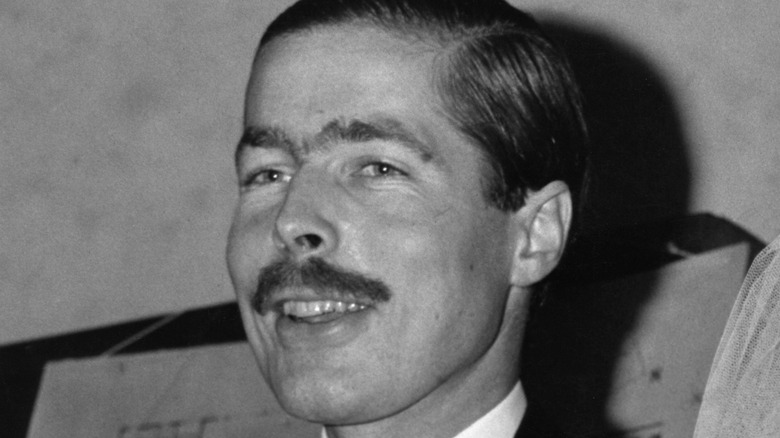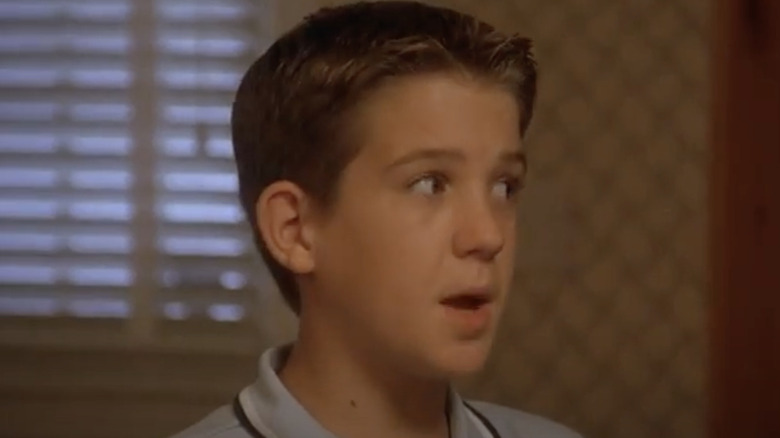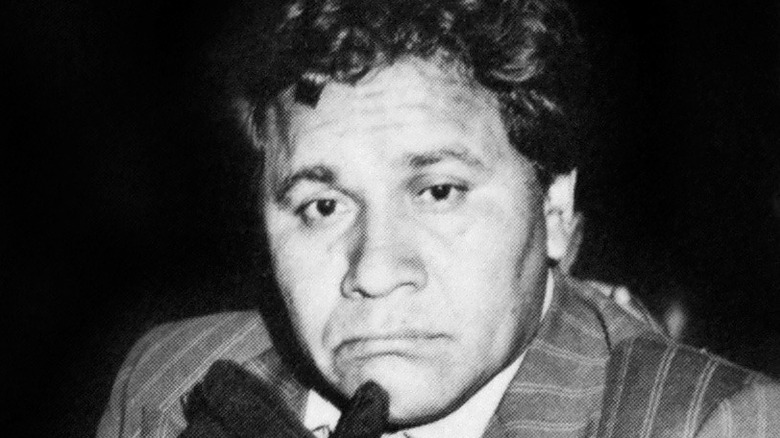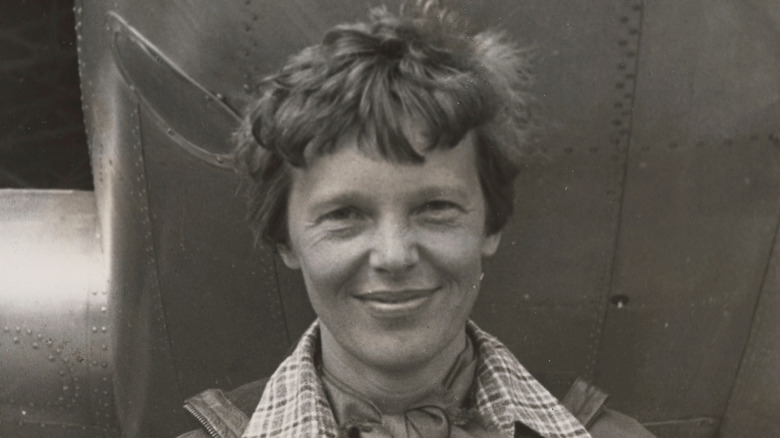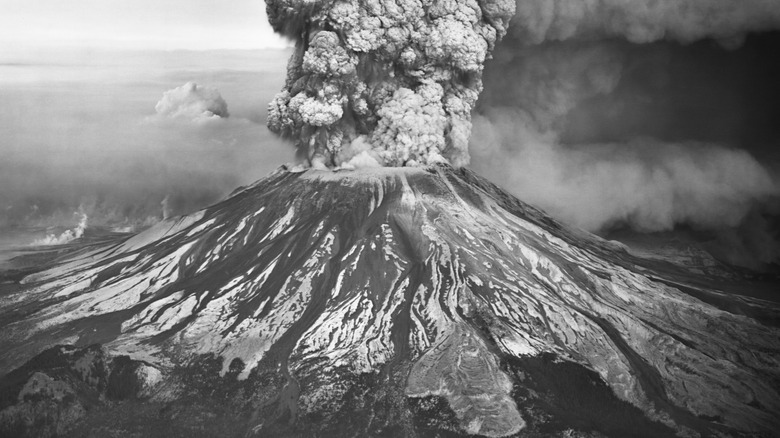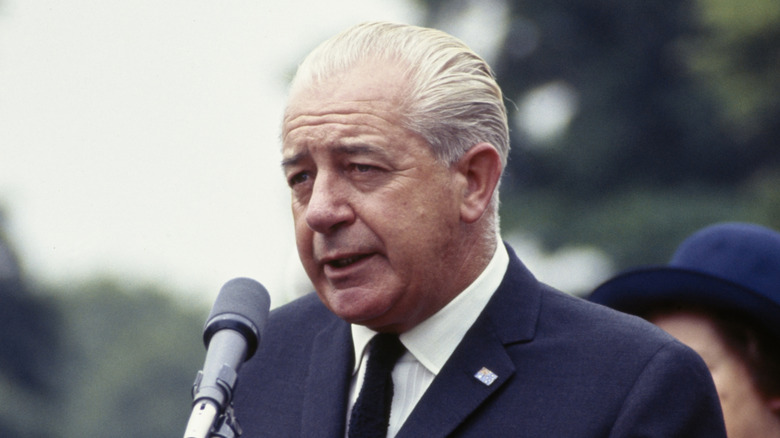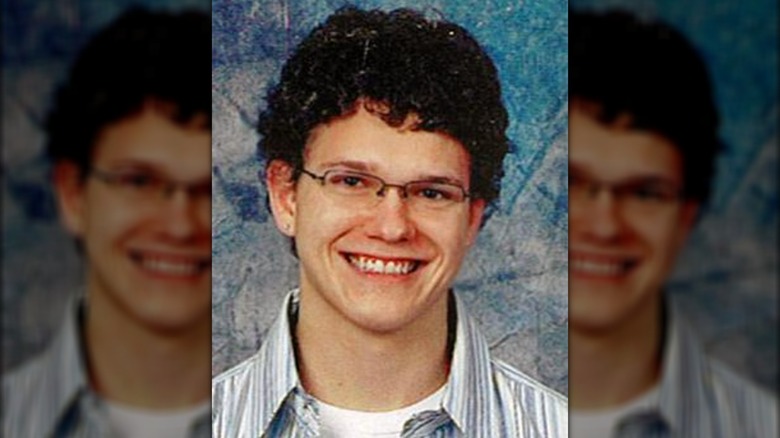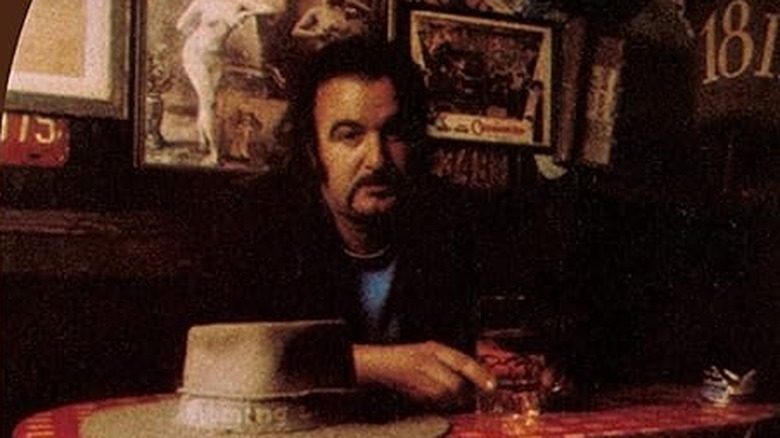Famous Last Words People Said Before They Disappeared
We may receive a commission on purchases made from links.
"Final words" are a fascinating phenomenon. Almost everyone hopes that when the moment of their eventual death transpires, they'll have enough time and clarity to impart some wisdom to their surrounding loved ones. In a perfect world, whether they're profound sentiment or a summary of what we've learned about life, last words are a compact legacy; a mic drop at the end of a life well lived.
But it probably rarely works out that way. Tragically, people often don't know when they're going to die, and particularly those who just up and mysteriously vanish for no discernible reason. One day, those individuals are living, breathing people, and the next, they're not around anymore, and with few clues as to how they disappeared in the first place. For those people, the final words they uttered privately or publicly thus take on added significance. Perhaps they are clues to the horrifying unknown events that happened without witnesses, or maybe they're bits of wisdom encrypted by the unusual circumstances of their death. Here are some of the most famous missing person cases of the last century or so, and the chilling final words those people uttered.
Lord Lucan
John Bingham was better known by his title, Lord Lucan, as he was the seventh Earl of Lucan in the U.K.'s stratified peerage system. A by-the-numbers aristocrat, Lord Lucan had attended England's finest schools, raced expensive vehicles, tended to his horses, and was apparently so debonair he was considered to play James Bond in the mid-1960s. Over the past 50 years, Lord Lucan has become infamous for his alleged role in a murder and his subsequent disappearance.
Lucan and his wife, Lady Lucan, had separated, and on the evening of November 7, 1974, she popped up in a London pub covered in blood and yelling that she'd fled from her former husband trying to murder her, after she'd discovered that he'd murdered their children's nanny, Sandra Rivett. Police found the murder weapon — a lead pipe — in a bag along with Rivett's remains.
Lord Lucan, meanwhile, fled the scene of the crime. According to a 1975 report filed in the county of East Sussex, England, he emerged the next morning at the home of his friends Ian and Susan Maxwell-Scott. Susan told detectives that she and Lucan had spoken briefly on the porch, and the conversation ended when he gave her a kiss on the cheek and said, "Goodbye, Susie. Thank you" (via The Daily Mail). A couple of days later, Lucan's car was found about a half hour's drive away by the ports of Newhaven. The aristocrat, who very likely would've been tried and possibly convicted of murder, disappeared completely.
Michael Rockefeller
Is the Rockefeller family cursed? With all of the tragedy that has befallen multiple generations of one of the wealthiest, most politically accomplished, and well-connected clans in American history, it's worth considering. The fate of Michael Rockefeller is perhaps the grisliest, and certainly the most baffling.
New York state Gov. Nelson Rockefeller had just started up the Museum of Primitive Art when he sent his son and fellow art appreciator, Michael, to bring back some pole art of the Asmat people of Indonesia in 1961. After some friendly exchanges with some Asmat villagers, he and some associates sailed through the area until their boat capsized. Rockefeller carefully swam toward land to seek rescue, uttering to anthropologist René Wassing, "I think I can make it." Then Rockefeller disappeared. What happened next is purely speculative. Some sources say he was devoured by sharks, or drowned, or was killed by Asmat warriors and then eaten. Michael Rockefeller was declared dead in 1964, although he was never seen alive again, nor were any of his remains ever recovered.
Art Scholl
After honing his craft as a stunt pilot in air shows and teaching flight at San Bernardino Valley College, agile airman Art Scholl became Hollywood's go-to person when a TV show or film required daring aerial footage. In the pre-CGI, practical effects era, deftly maneuvering airplanes had to be filmed for real, and Scholl was often the pilot behind those sequences captured for projects like "The Great Waldo Pepper," "Blue Thunder," "Black Sheep Squadron," and "The Right Stuff." In the fall of 1985, Scholl secured his biggest and ultimately final gig: stunt flight work for "Top Gun."
There are more fatal accidents on movie sets than one might think, and one likely claimed the life of Scholl. The script called for an upside-down spin, and during filming, Scholl lost control of his plane at around 4,000 feet in the air. After plummeting to 3,000 feet, Scholl radioed, "I've got a problem" (per Military.com). A few seconds and another 1,500 feet later, Scholl reiterated, "I've really got a problem." Scholl and his plane then crashed into the Pacific Ocean five miles off the coast of California. An entire day of search and rescue efforts couldn't find a trace of the aircraft or the pilot.
Hart Crane
One of the great practitioners of the early 20th-century modernist movement in poetry was Hart Crane. Writing in a classically overwrought yet confessional and intellectual manner, the promising writer earned favorable comparisons to giants like Walt Whitman and T.S. Eliot. His most famous and well-received work was 1930's "The Bridge," an epic poem about the Brooklyn Bridge and how it was a symbol of the idea of America. Following the death of his father – Ohio candy magnate Clarence Arthur Crane – in 1931, the younger Crane grew deeply depressed and withdrawn. After traveling to Mexico to fulfill the terms of a Guggenheim fellowship to write about the 16th-century Spanish conquest, Crane headed back to New York City.
Somewhere in the Gulf of Mexico, Crane went overboard. It's unclear whether his leaving the ship was intentional or accidental, although the last words he uttered would suggest the former. Just after a sailor on the boat rejected Crane's romantic advances and assaulted him, the poet called out, "Goodbye everybody," and then disappeared. Crane was never heard from or seen again, dead or alive.
Joe Pichler
As a child and then teen actor in the 1990s and 2000s, Joe Pichler carved out a modest career with roles in movies and episodic television series. Audiences may have spotted the Washington-based young performer in episodes of "Touched by an Angel," "Lois and Clark: The New Adventures of Superman," and "In the House," or in the movies "Varsity Blues" and "Music from Another Room." His most popular and prominent work was playing Brennan Newton in two direct-to-home video installments of the "Beethoven" series of dog movies. His last credited work came in the 2002 movie "Children on Their Birthdays," when Pichler would've been about 15 years old.
In January 2006, just a few weeks before he was set to turn 19, Pichler departed his apartment in his hometown of Bremerton, Washington. He left all the lights on, and all he apparently took with him was his wallet and car keys. Four days later, local police found Pichler's car near the Port Madison Narrows, leading to a theory that he may have jumped off a bridge spanning that waterway. No supporting evidence, or Pichler, ever manifested. All the former actor left behind was a note in his car, expressing a desire to be a "stronger brother" to his siblings (per NBC's "Today").
If you or someone you know is struggling or in crisis, help is available. Call or text 988 or chat 988lifeline.org
Oscar Zeta Acosta
A significant figure in the Chicano rights and identity movement in the 1960s and 1970s, Oscar Zeta Acosta was an advocate and attorney for his cause. Also a member of the Air Force, Acosta was an author of groundbreaking novels that were loosely based on his own experiences: "The Autobiography of a Brown Buffalo" and "The Revolt of the Cockroach People." But Acosta was most famous and remembered for his association with the self-described gonzo journalist Hunter S. Thompson. The latter helped forge the legends and lore about the former, publishing a widely read profile of him in 1971 and detailing their harrowing, heavily drug-fueled adventures in "Fear and Loathing in Las Vegas." A cult classic and primary text of nonfiction journalism, Acosta was depicted as a man who coped with mental health issues and who was prone to fits of rage and inscrutable behavior.
While in Mazatlan, Mexico, in May 1975, the 39-year-old Acosta placed a call to his son, Marco. His final words before he hung up concerned how he was "about to board a boat full of white snow" (via Historic Mysteries). Those enigmatic words fueled many theories about what became of Acosta. He may have suggested that he was about to board some kind of illegal drug trafficking vessel, or that he ingested powerful substances and then engaged in some kind of misadventure that got him killed. It's hard to say, because Acosta disappeared for good after that phone call.
If you or anyone you know needs help with addiction issues, help is available. Visit the Substance Abuse and Mental Health Services Administration website or contact SAMHSA's National Helpline at 1-800-662-HELP (4357).
Amelia Earhart
In the 1930s, Amelia Earhart made history. A rightfully beloved hero to the masses and one of the most famous people on Earth at the time, she accomplished numerous astonishing aviation feats when flying a plane was still relatively new and viewed as a daring rarity. In 1932, for example, she flew solo across the Atlantic Ocean, and for her efforts received the American Distinguished Flying Cross. Five years later, and with her navigator Fred Noonan along for the ride, Earhart took off from Miami with the goal of becoming the first woman to completely circumnavigate the planet in an airplane.
On July 2, a month into the journey, Earhart and Noonan reached New Guinea. Dealing with bad weather conditions and a dangerously low level of fuel, they lost touch with their Coast Guard liaison before they could reach their intended target landing spot on the uninhabited and remote Howland Island. Before she lost contact — forever, it would seem — Earhart radioed to the Coast Guard, "We are on line 157, 337" (via The Cougar Star).
An amateur radio operator picked up a later message, reportedly from Earhart, with the pilot barely heard as she uttered with palpable panic, "Waters high," "Help us quick," and "We have taken in water, my navigator is badly hurt. We are in need of medical care and must have help. We can't hold on much longer." Conclusive proof of Earhart's final fate or whereabouts were never determined.
David A. Johnston
The most powerful volcanic eruption in U.S. history occurred on May 18, 1980. Mount St. Helens, a 9,600-foot gem in Washington state's Cascade Range mountains, was rocked by a magnitude 5.1 earthquake, capping off two months of volcanic events that involved thousands of smaller earthquakes and natural explosions. The blast was devastating, removing about 1,300 feet from the top of Mount St. Helens and sending gas, steam, and rock into the surrounding areas at a rate of 680 miles per hour and at temperatures as severe as 570°F. Four billion trees were knocked down, and dozens of square miles surrounding the volcano were buried in landslides and ash.
Because Mt. St. Helens had been so active in the lead-up to the events of May 18, 1980, volcanologists were stationed in the vicinity for research purposes. Thirty-year-old David Johnston worked for the U.S. Geological Survey, and at 8:32 a.m. on eruption day, he sent out a message to a contact at a distant office via ham radio. "Vancouver! Vancouver! This is it," Johnson called out. Personal effects and camping gear thought to belong to Johnston were found on Mount St. Helens in 1993; Johnston's body was never recovered.
Harold Holt
Harold Holt was 59 years old, head of Australia's ruling Labor Party, and the Prime Minister of his country when he became lost at sea and one of a handful of politicians who are still missing today. On a warm summer morning in December 1967, he was on a small vacation with three friends at Cheviot Beach near Melbourne, and after watching star sailor Alec Rose reach shore on his global boating trip, Holt persuaded his party to stop and go for a swim. An accomplished and expert swimmer, even in tricky environments like the ocean, Cheviot Beach was one of his favorite haunts.
Member of Parliament Alan Stewart was the only other person in the group who took up Holt's offer of a swim, and after a few brief moments in the water, he retreated, intimidated by a powerful undercurrent. That same undercurrent was as dangerous as Stewart feared: It grabbed ahold of Holt and pulled him farther from view until he was unseen. His body never resurfaced, and Holt was never found alive or dead, despite an instant and immediate 200-person search and rescue team. In a chilling ironic twist, the last thing Holt told his friends before he went for a swim was that he would be quite safe, because he knew that area of ocean "Like the back of my hand" (via Sky History).
Brandon Swanson
In the early morning hours of May 14, 2008, 19-year-old Brandon Swanson left a party in Canby, Minnesota, and began to drive back to his parents' home in Marshall, Minnesota. While traversing a rough dirt road, he drove his car into a ditch and couldn't get the vehicle out, and so he called his parents at just before 2 a.m. to request a ride home. He agreed to meet them in the small town of Lynd, a moderate walk away through the wilderness.
Brian and Annette Swanson stayed on the line with their son as he walked through the area, keeping up the conversation for safety's sake for 47 minutes. "All of a sudden he said, 'Oh s***!' and then the phone went dead," Brian Swanson told the St. Paul Pioneer Press. "There was nothing after that." Rescue personnel at first believed that Swanson fell into the Yellow Medicine River, but a search proved fruitless, as did one of the Mud Creek area. Two more searches in 2013 and 2015 didn't turn up Swanson either.
Lars Mittank
In 2014, a group of German tourists spent a few summer days at the Golden Sands resort in Varna, Bulgaria. One night, a member of the party, 28-year-old Lars Mittank, headed out on his own and got into a soccer-related scuffle in a bar. He was reportedly heavily beaten by four men, and sustained a ruptured eardrum in the melee. He sought emergency medical attention and a doctor prescribed the antibiotic cefuroxime; he also forbade Mittank from flying home with his friends on their flight scheduled for July 7, recommending he allow his ear to heal more before he attempted travel.
Then Mittank developed paranoia, frantically calling his mother in Germany and claiming that he was being followed by drug-seeking strangers. She booked her son a flight home, and Mittank calmly went to the Varna airport, but he went to the medical office instead of getting on the plane. Growing increasingly agitated, Mittank reportedly told the attending physician (via The Daily Mail), "I don't want to die here. I have to get out of here." And then he ran, leaving behind his phone and luggage.
Airport security cameras caught footage of Mitank sprinting out. Then he climbed over a fence and was never seen in Germany or Bulgaria again. There are many theories as to what really happened to Mittank. Cefuroxime can, but rarely does, trigger psychosis. Or he may have been experiencing a mental health episode as a result of a head trauma sustained in the earlier bar fight.
Jim Sullivan
A cult favorite and early pillar in the singer-songwriter era of the 1970s, Jim Sullivan recorded just two acclaimed albums for a small label: 1969's "U.F.O." and 1972's self-titled LP. The former was loaded with songs about isolated desert roads and alien visitations, which would seem prophetic after Sullivan's disappearance a few years later, as well as inspiring some audacious theories about why he was never seen alive ever again.
In what was perhaps his last documented conversation in 1975, Sullivan spoke with his manager, who asked him if he were to theoretically ever disappear, how would he go about making that happen. "I'd walk into the desert and never come back," Sullivan responded (via The Rodeo). In March of 1975, he departed California, heading for Nashville, and after spending a night in a motel in Santa Rosa, New Mexico, he drove his Volkswagen to a ranch more than 20 miles away from a population center. His guitar, clothes, and wallet were inside the car, but Sullivan was gone. Friends and fans have theorized that Sullivan abandoned his previous identity and started a new life, or that he was so in tune with aliens that he was abducted by a cadre of them.

